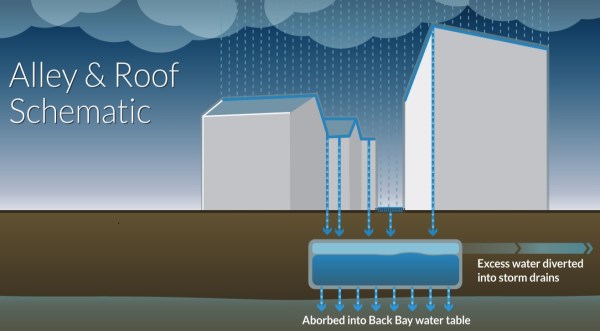What is a Green Alley?
by Jim Newman, Linnean Solutions — I get this question all the time, when I say that Linnean is monitoring a green alley in Boston. As a quick explanation, this alley between two buildings on an urban college campus covers a total of 6,000 square feet. However, it handles the stormwater from 24,000 square feet of roofs and paved area.
Key Organizations:
- Linnean Solutions
www.LinneanSolutions.com - Boston Groundwater Trust (Long-term monitoring of groundwater levels)
www.BostonGroundwater.org - Charles River Watershed Association
www.crwa.org
There are 3 qualities that define how an alley (and the rainwater management system it embodies) can be considered “green”, and it’s all aimed at restoring a more natural water cycle.
- A Green Alley keeps water out of the City or town’s storm sewers.
Parts of Boston still have combined storm and waste sewer systems, including the area around the this campus. Keeping rainwater from overflowing into the Charles River is a priority. - A Green Alley helps clean pollutants out of the rainwater.
Water picks up phosphorus, nitrates, and hydrocarbons when it hits the streets in Boston. Infiltrating rainwater into the ground, rather than collecting it in storm sewers helps clean those pollutants out. Eliminating so called non-point-source pollutants are a high priority in the ongoing efforts to clean up the Charles River. - A Green Alley replenishes the underlying groundwater table by allowing water to absorb through permeable bricks and pavement.
In Boston’s Back Bay, high levels of impervious surfaces have lead to a dropping water table. This is a problem for the hundreds of buildings built on wooden pilings. Systems that direct rainwater into the water table are a priority.

Linnean’s role is to monitor the effectiveness of the Green Alley system. To accomplish this monitoring, Linnean worked with a hydrological engineering firm to design a low-cost monitoring system. This system consists of a rain monitor, 3 automated water flow monitors, an automated groundwater level monitor, and twice-yearly water quality tests. All of these monitors (except the water quality tests) automatically report to a Web-based display that will be available to the public. The public will be able to see total daily rainfall, along with the percentage of rainwater that is infiltrating into the water table. Everyone will be able to see how effective this particular green infrastructure is.
And it turns out that the Green Alley is pretty darn effective!
In our preliminary monitor readings, over the last 3 months, no water was detected leaving the Green Alley system. In other words, the Green Alley diverted ALL of the rainwater that fell on the site — over 87,000 gallons of water — into the ground and away from the Boston storm sewers. This is great news for Boston, for the Charles River, for the water table under Back Bay, and for your project! This demonstrates that such a water diversion and infiltration system (with the right soil conditions) can handle a large portion of storm water from your site. Soon, everyone will be able to play along with a live web display.